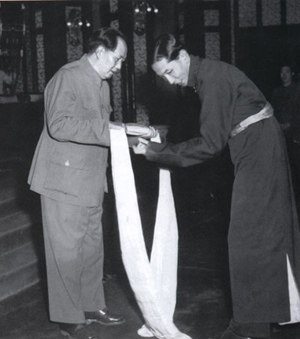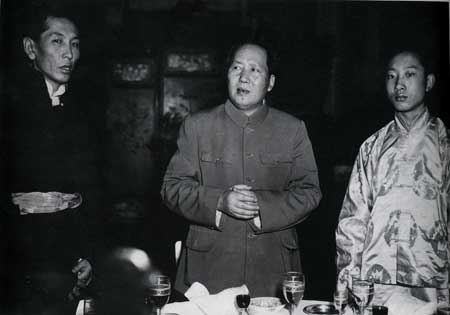The representatives on behalf of the local government of Tibet to attend the signing ceremony were appointed by the Dalai Lama himself.
However, since he tore up the Agreement and fled abroad in 1959, the Dalai Lama has often claimed in public "the legality of the 17-Article Agreement is worth doubting." He wrote in his autobiography that he had first known the news about the signing ceremony over the radio: "A burst of serious voice read out the 17-Article Agreement on measures for 'peaceful liberation in Tibet' signed between the People's Republic of China and its so-called 'local government of Tibet.' I simply could not believe my own ears."
Let us look at the facts:
"In 1951, I sent representatives to Beijing to negotiate with the Central People's Government. Signed on the basis of the principle of unity and fraternity was the Agreement of the Central People's Government and the Local government of Tibet on Measures for Peaceful Liberation of Tibet. Since then, the Tibetan people have been freed from the enslavement of imperialism and returned to the big family of the motherland. They have been able to enjoy the same right of equality as other fraternal ethnic groups in China, and begun to embark on the bright road of freedom and happiness. " This speech was delivered by the Dalai Lama on the inaugurating meeting for the Preparatory Committee of Tibet Autonomous Region. In accordance with the Agreement, he served as the chairman of the committee, which was set up on April 22, 1956.
The five representatives on behalf of the local government of Tibet were sent from Tibet's capital of Lhasa and Yadong. The representatives from Lhasa were Tubdain Laimoin ("Kanqiong" meaning the fourth-rank monk officials next only to "Galoons," Tibetan officials to handle the regional political affairs), Sangpo Tainzin Toinzhub (commander of a regiment of the Tibetan Army). Together with Ngapoi Ngawang Jigmei (Galoon), they went to Beijing via Qamdo, Chengdu, capital of southwest China's Sichuan Province. Kemei Soinam Wangdui (the commander of the Tibetan Army) and Tubdain Dainda (a monk official), sent from Yadong, went to Beijing by way of India, Hong Kong, and Guangzhou. Dalai Lama's brother-in-law Yaoxi Phuntsog Tashi went with them as an interpreter.
 |
|
Photo shows Ngapoi Ngawang Jigmei, chief representative of the local government of Tibet, presents Hada, a symbol of best wishes in Tibet, to Chairman Mao Zedong of the Central People's Government on May 24, 1951. (Xinhua File Photo) |
Tubdain Dainda wrote in "Tibetan Cultural and Historical Data Anthology" published in 1982: "We met with the Dalai Lama before leaving. Gaxag (the local government of Tibet) issued each representative a certificate with an official stamp, marking the name and identity on the cover. And the content of "acknowledging that Tibet is part of China" was written in it. We were instructed to promise to pay tributes to the Central Government and we were forbidden to make any other promise. Moreover, we were asked to take a letter written by Dalai Lama to Indian Prime Minister Nehru…Soon we met the other three representatives who had arrived in Beijing earlier and delivered the certificates and the Dalai Lama's instructions to them. Then we paid a formal visit to the leaders of the Central Government and submitted the Dalai Lama's letter and gifts." He also wrote: " In order to enable the Dalai Lama to learn about the details in negotiations and accept the agreement, we five representatives always invited Yaoxi Phuntsog Tashi to join our discussions. On May 23, we signed the 17-Article Agreement with the central delegation and made it public to the whole world. Meanwhile, we cabled to the Dalai Lama and Gaxag about the specific terms of the agreement."
Before the founding of New China in 1949, Beijing, Xinjiang(west China's Xinjiang Uygur Autonomous Region), Chengdu (capital of southwest China's Sichuan Province), and Kunming(capital of southwest China's Yunnan Province) had been liberated in a peaceful way. Soon afterwards, the central government called for peaceful liberation of Tibet and invited the local government of Tibet to peace negotiations. However, the imperialist-controlled Tibetan local government continued to expand armament and impose barriers, and rejected peace negotiations.
The former governor of east Tibet's Qamdo Prefecture Ngapoi Ngawang Jigmei petitioned to Gaxag for negotiations with the PLA, but he failed to obtain approval. After Qamdo's liberation, Ngapoi Ngawang Jigmei witnessed how the PLA observed the Three Main Rules of Discipline and Eight Points for Attention. Having talked with the commanders of the PLA Tibet Garrison many times, he came to know the central government's policy on ethnic and religious affairs. He also came to realize that the decision of the Central Government to liberate Tibet peacefully was totally out of consideration of Tibetan people's interests and the state of the former Tibetan local government.
In October 1950, Ngapoi Ngawang Jigmei petitioned to Gaxag again for peace talks with the Communist Party of China (CPC). He recalled: "Discussions were held in Qamdo, but the officials in Gaxag, blinded by foreign hostile forces' rumors, were still in the dark about the truth. A total of 40-odd officials signed a letter to Gaxag to petition for peace talks with CPC."
Jinzhong Gyaincain Puntsok said: " Ngapoin sent Gachong Sanglin and me to deliver a letter to Gaxag. We set out from Qamdo and arrived in Lhasa one week later on October 30. At that time, some Galoons asked us 'how's everything going on in Qamdo after liberation?' 'Who were killed?' ' How many people died?' I told them directly that all the nobles including Governor Ngapoin were all alive, with nobody killed. (The PLA troops) were just stationed outside the suburbs of Qamdo, and did not enter the city or did bad things, showing a high sense of observing discipline."
Having heard the report from Qamdo, Gaxag convened a session of all high-ranking officials and representatives of the Sera, Prepung and Gandain monasteries. After three days of discussions, they decided to accept the proposal for peaceful liberation of Tibet and agreed to send representatives to peace negotiations.
Earlier before this time, pro-imperialist Regent Dadrak stepped down on October 8 so that the 16-year-old Dalai Lama came to power. One month later, the Dalai Lama fled to a border town of Yadong via Lhasa, waiting for chances to flee to India or the United States. On the one hand, he contacted the Indian government in probing the possibility of going abroad. On the other hand, he wrote to leaders of the PLA troops stationed in Qamdo.
On December 17, 1950, the Dalai Lama wrote to Wang Qimei, deputy commander of the 18th Army of the PLA, and Wu Zhongxin, commander of the 52nd division of the PLA: "As for the recent report from Galoon Ngapoi, governor of Qamdo, and his subordinates, we have sent representatives to talk with the PLA. If you return me the occupied monasteries and land in the Kang area, I think the Honorable Mr. Mao Zedong will enjoy a higher reputation around the world, and you will be much appreciated. Please think it over and I am looking forward to your early reply."
Here Gaxag was divided in opinion: fleeing abroad or negotiating with CPC.
On January 18, 1951, the Dalai Lama, trapped in such a dilemma, finally approved Gaxag's decision to negotiate with CPC and he wrote Chinese Ambassador to India Yuan Zhongxian a letter, which was handed to Mao Zedong afterwards. He said: "I have sent a delegation headed by Ngapoi to Beijing as soon as possible. But the distance is so long that they cannot get there in time. So we appointed another two assistants to Ngapoi: Zhasa Suokang Suba and Kamchong. They two will go to Beijing via India and report to you the details about our meetings and people's opinions. May you send this letter to Chairman Mao Zedong in hope of promoting the Tibetan-Han ties."
Yuan replied to him on February 1: "Chairman Mao asked me to represent him to congratulate you on your enthronement. I've submitted your opinion to the Central People's Government, which instructed that you are always welcome to send representatives to Beijing for the peace negotiations. We have wired the PLA troops stationed in Qamdo to treat the representatives well upon their arrival and escort Ngangpo and the other two representatives to Beijing as soon as possible."
Although the Dalai Lama had approved the sending of representatives to the peace negotiations, he set five conditions. The most important was that the PLA troops could not enter Tibet and those already stationed in Ngari and Qamdo should withdraw to inland areas. Ngapoi Nagwang Jigmei wrote in "Great Progress in Tibet's Development" published on December 26, 1990: "Considering the significance of the peace negotiations and yet Gaxag's conditions are so far from the Central People's Government's principle as to be barriers to the peace negotiations, I decided to write to the Dalai Lama to express my view frankly before departure. I said that I would rather sacrifice my life for ideal under the circumstances. For this trip to the Han area, I would try my best to negotiate with the Central Government. As for the wording 'Tibet is part of China', I put it in this way that the five major ethnic groups in China are all equal and live in unity and on friendly terms. 'Marching into Tibet for national defense' does not mean in the least interfering in Tibet's internal affairs. The reason why PLA troops should be stationed in Tibet is that the current world situation is turbulent and unstable. If we refuse to make our commitments on the above two points, there will be nothing to talk about between the Han people and Tibetan people."
 |
|
Photo shows the 10th Panchen Erdeni Qoigyi Gyaincain(R), Mao Zedong(M) and Ngapoi Ngawang Jigmei(L). Chairman Mao makes a speech at the dinner to celebrate the signing of the 17-Article Agreement on May 24, 1951. (Xinhua File Photo) |
On the next day after signing the 17-Article Agreement, the Central People's Government gave a dinner to celebrate the signing of the Afgreement. Mao Zedong made a speech on the feast: "For hundreds of years the various ethnic groups in China had not been in unity. Particularly, the Han and Tibetan people had been in disunity. Disunity also existed within each ethnic group. This was the result of the rule of the reactionary Qing government and the Chiang kai-shek's government, as well as the result of sowing of dissension by imperialists. "
"Now, the force led by the Dalai Lama and the force led by the Panchen Erdeni have become united together with the Central People's Government. This was achieved only after the Chinese people overthrew the Imperialist and the domestic reactionary forces. This unity is the outcome of the concerted efforts of people from all walks of life. From now on, based on such unity, all ethnic groups around the country will achieve progress and develop in all areas such as political affairs, economy and culture."

